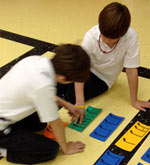In the Orff Schulwerk approach, learning music by rote processes is considered valid in its own right. Learning to read music notation is seen as a logical extension of being able to make music. No particular method of teaching music reading is recommended. In the United States, moveable do with tonic sol-fa and the Curwen hand signs have come to be used frequently for vocal development. Letter names must certainly be employed in playing the barred instruments and recorder. Experimental graphic notation, hand levels, the hand staff, scale numbers, rhythm syllables—all these and more—have been used effectively in developing literacy skills; different situations will call for different means. The guiding principles are that notation and reading be built on known musical materials and that sound precede symbol.
The purpose of Orff Schulwerk is to awaken the artistic potential in every individual and offer a context in which this can be exercised. The Orff Schulwerk approach as a model for learning involves a much broader spectrum of artistic activity than is traditionally included in music. It is “never music alone but forms a unity with movement dance and speech.”1 It is not intended to develop highly accomplished performers. The emphasis is on process rather than performance; on participation by all, each at his or her own level; and on the cultivation of skills for creating and developing ideas within music and dance rather than reproducing set forms. Learning results from the mutually stimulating interaction of instructor and students, the freedom and opportunity to take risks, and the accomplishment of creative tasks appropriate to each stage of development.
1Carl Orff, “Orff-Schulwerk: Past and Future,” in Orff Re-Echoes, ed. Isabel McNeill Carley (Cleveland, OH: American Orff-Schulwerk Association, 1977), 6.
← Back To More On Orff Schulwerk




